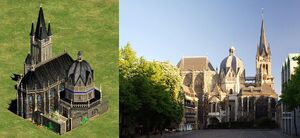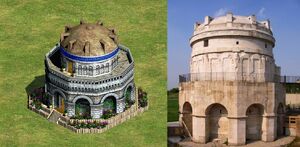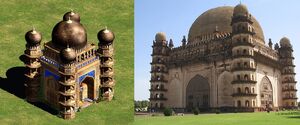| This article is about the building in Age of Empires II. For the building in other games of the series, see Wonder. |
| “ | Building a Wonder of the World demonstrates the superiority of your civilization. Constructing a Wonder that stands for a certain period of time is one way to win the game. | ” |
| —Age of Empires II description | ||
The Wonder is a civilian building in Age of Empires II that becomes available once the Imperial Age is reached. In certain game modes, the Wonder grants victory if built and defended for 200 years.
Each civilization builds a Wonder of historically relevant and unique appearance. They cannot be converted.
Tactics and placement
Wonders only serve as a victory condition, and as such they must be used only in game modes that allow that kind of victory. When a player starts to build a Wonder, every other player receives a notification with the location of the Wonder so they know where to steer their aggression.
Wonders should be placed in a well-defended area so it is better to first build up a strong fortification composed of Castles, walls, and towers, so basically perform a late-game turtling strategy. In any case, the player must be prepared to be the main focus of all enemy attacks and prepare to defend the Wonder. It is advised to have a huge army to defend against attacking armies, particularly siege units. Since the Wonder takes incredibly long to be built, it is advised to build it with as many Villagers as possible while also leave them near the area once they finish in case the Wonder needs to be repaired. In team games, the support of allies while defending is highly valuable.
It is possible (but costly) to build more than one Wonder so that if one does not stand, other Wonders can stand for the time required to win the game. In The Conquerors, if the player has multiple Wonders and one is destroyed, the timer will reset but still be displayed. Although highly unlikely, if multiple players finished their Wonder at the same time, the player in the highest slot regardless of the color wins once the countdown ends.
A Monument (an unconstructable building) can be found in the Scenario Editor and some campaigns. Its appearance varies being different for each civilization, much like the Wonder, and it has the same icon, although it merely functions as decorative. It has 9999 hit points, making it the bulkiest building in the game.
List of Wonders
The Age of Kings
Britons

The Aachen Cathedral and its real life counterpart
Wonder: Aachen Cathedral
Campaign appearances:
Byzantines
The Hagia Sofia and its real life counterpart
Wonder: Hagia Sophia
Campaign appearances:
Celts
The Rock of Cashel and its real life counterpart
Wonder: Rock of Cashel
Campaign appearances:
Chinese
The Temple of Heaven and its real life counterpart
Wonder: Temple of Heaven
Campaign appearances:
Franks

The Frankish Wonder and its real-world counterpart
Wonder: St. Vitus Cathedral
Campaign appearances:
Goths

The Theodoric I Mausoleum and its real life counterpart
Wonder: Mausoleum of Theoderic I
Japanese
The Tōdai-ji Temple and its real life counterpart
Wonder: Tōdai-ji
Campaign appearances:
Mongols
The Great Tent of Genghis Khan and a medieval depiction of the tent
Wonder: Great Tent of Genghis Khan
Campaign appearances:
Persians
The Taq-i Kisra Palace and its real life counterpart
Wonder: Taq-i Kisra Palace
Campaign appearances:
Saracens
The Great Mosque of Samara and its real life counterpart
Wonder: Great Mosque of Samarra
Campaign appearances:
Teutons
The Maria Laach Abbey and its real life counterpart
Wonder: Maria Laach Abbey
Campaign appearances:
Turks
The Selimiye Mosque and its real life counterpart
Wonder: Selimiye Mosque
Campaign appearances:
Vikings
The Borgund Stave Church and its real life counterpart
Wonder: Borgund Stave Church
Campaign appearances:
The Conquerors
Aztecs
The Great Pyramid of Tenochtitlan and a render of its real life counterpart
Wonder: Great Pyramid of Tenochtitlan
Campaign appearances:
Huns
The Arch of Constantine and its real life counterpart
Wonder: Arch of Constantine
Koreans
Hwangyong Temple and a miniature reconstruction of the temple
Wonder: Hwangnyong Temple
Campaign appearances:
Mayans
The Temple of the Great Jaguar at Tikal and its real life counterpart
Wonder: Temple of the Great Jaguar
Campaign appearances:
Spanish
The Torre del Oro and its real life counterpart
Wonder: Torre del Oro
Campaign appearances:
The Forgotten
Incas
The Sun Temple of Machu Pichu and its real life counterpart
Wonder: Temple of the Sun at Macchu Picchu
Campaign appearances:
Indians

The Gol Gumbaz and its real life counterpart
Wonder: Gol Gumbaz (in The Forgotten and The African Kingdoms)
Brihadeeswarar Temple and its real life counterpart
Wonder: Brihadeeswarar Temple (since Rise of the Rajas)
Campaign appearances:
Italians
The Saint Lawrence Cathedral and its real life counterpart
Wonder: Cathedral of St. Lawrence
Campaign appearances:
Magyars
The Hunyad Castle and its real life counterpart
Wonder: Hunyad Castle
Slavs
The Kizhi Pogost and its real life counterpart
Wonder: Kizhi Church
The African Kingdoms
Berbers
The Hassan Tower and its real life counterpart
Wonder: Hassan Tower
Ethiopians
Bete Amanuel and its real life counterpart
Wonder: Biete Amanuel
Malians
Great Mosque of Djenne and its real life counterpart
Wonder: Great Mosque of Djenné
Campaign appearances:
Portuguese
The Belém Tower and its real life counterpart
Wonder: Belém Tower
Campaign appearances:
Rise of the Rajas
Burmese
Shwezigon Pagoda and its real life counterpart
Wonder: Shwezigon Pagoda
Campaign appearances:
Khmer
Angkor Wat and its real life counterpart
Wonder: Angkor Wat
Campaign appearances:
Malay
Kalasan Temple and its real life counterpart
Wonder: Kalasan Temple
Campaign appearances:
Vietnamese
But Thap Temple and its real life counterpart
Wonder: Bút Tháp Temple
Campaign appearances:
Further statistics
| Building strengths and weaknesses | |
|---|---|
| Strong vs. | Nothing |
| Weak vs. | Everything |
| Upgrades | |
| Hit points | |
| Armor | |
| Line of Sight | |
| Construction speed | |
| Other | |
Civilization bonuses
- Byzantines: Wonders have +40% HP. Town Watch is free.
- Chinese: Technologies that benefit Wonders are 20% cheaper.
- Incas: Wonders cost 15% less stone.
- Malians: Wonders cost 15% less wood.
- Persians: Researching Town Watch and Town Patrol is 20% faster.
- Spanish: Wonders are built 20% faster.
Team bonuses
- A team containing Malians: Researching Masonry, Architecture, and Treadmill Crane is 80% faster.
Changelog
The Forgotten
- Indians: The Wonder is the Gol Gumbaz.
Rise of the Rajas
- Indians: The Wonder now is the Brihadeeswarar Temple. The Gol Gumbaz is still available in the Scenario Editor.
Trivia
- The Briton Wonder is actually in Germany.
- The base of the Celt Wonder was slightly altered and reused as a base for the Mediterranean style Castles.
- The Wonder is the only constructable building that does not have the standard building armor class, along with the Fish Trap.
- It is the only item in the game to cost three different resources.
- The Slav Wonder is anachronistic, as the Khizi Pogost was not built until the 17th century. A more accurate choice would've been the Moscow Kremlin when it was a Limestone Citadel, the Dormition Cathedral, or the Ferapontov Monastery.
- The design for the Malian Wonder is anachronistic by necessity. It is based on the current appearance of the Great Mosque of Djenne, but the mosque was rebuilt in the early 20th century. The original mosque would likely have looked different, but no records exist that describe its appearance, so it remains unknown. The architect for the original mosque was from Egypt, so it is possible that it would have been similar to medieval Egyptian mosques in appearance.
- The Berber Wonder is actually the minaret of an unfinished mosque. Even the tower itself has only half of its originally intended height. Thus that Wonder is an incomplete building.
- A few Wonders are resembled again as other buildings in the Scenario Editor: There is the Arch of Constantine, which is very similar to the Hunnic Wonder, the Gol Gumbaz, which used to be the Indian Wonder, the Mosque, which is even identical in appearance to the Turkish Wonder, and the Cathedral, which looks like a taller version of the British Wonder.
History
| “ | One distinguishing cultural characteristic of the great Middle Age civilizations was architecture. Buildings in Japan, Scandinavia, Britain, Constantinople, and Arabia looked quite different and employed different construction techniques. In many cases, particularly noteworthy buildings stand as icons for the building civilization, marking it for all time as a culture that achieved greatness, if only temporarily. Examples of such Middle Age cultural icons are the Cathedral at Chartres, Charlemagne’s Palace, and the Hagia Sophia at Constantinople. | ” |
| —Age of Empires II manual | ||
Video overview

Everything You've Wondered About Wonders
Template:Buildings AoE2
